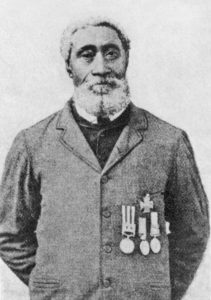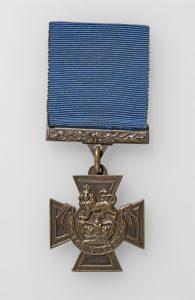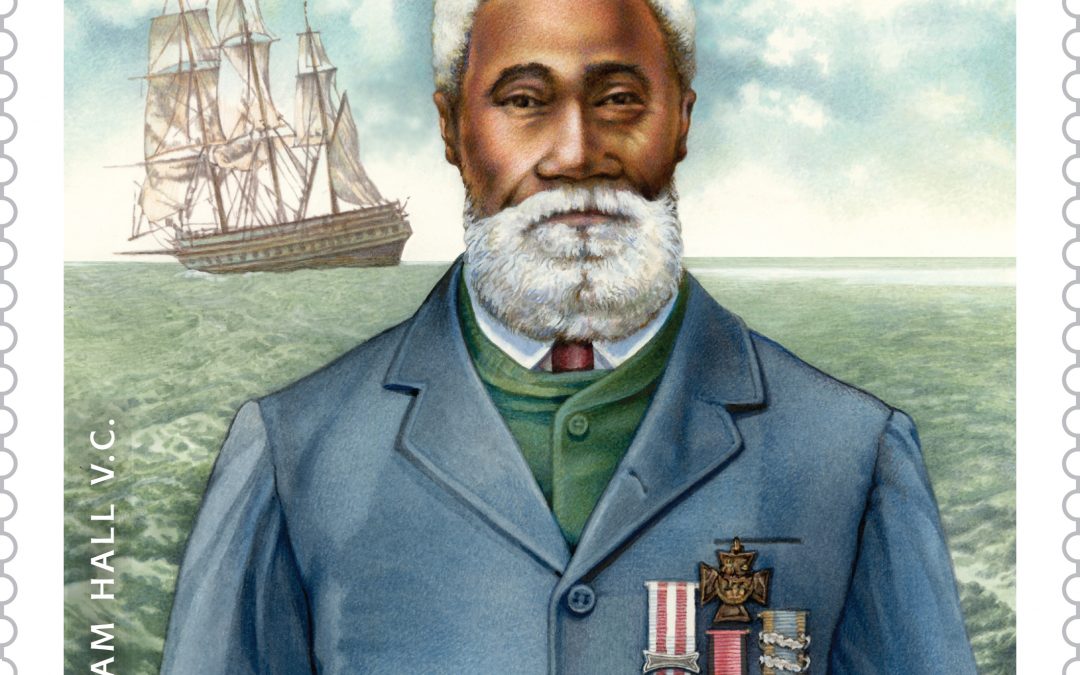Credit: Nova Scotia Museum
By Erica Phillips, BA, MA
 When most people think of contributors to Canada’s war efforts and those who served with distinction, they have one type of person in mind.
When most people think of contributors to Canada’s war efforts and those who served with distinction, they have one type of person in mind.
Black Canadians have served with honour— even pre-confederation. Navy man William Hall of Nova Scotia is one such example.
William Neilson Edward Hall, VC of Nova Scotia was awarded the Victoria Cross in 1859; the first Black man, the first seaman, and the first Nova Scotian to earn the distinction. In Canada, the Victoria Cross is the highest award for military valour and the British Empire’s highest honour for bravery. Hall had served under the British in the Indian Rebellion of 1857.
Born in *Horton Bluff, N.S. in April 1827, Hall was the son of freed slaves. While on board a slave ship from Africa to North America, his parents— Jacob and Lucinda Hall— were freed by the Royal Navy during the War of 1812.
William Hall worked in shipyards in Hantsport, N.S. and built wooden ships for the merchant marines travelling the world, working on merchant ships as a deckhand. As a sailor he saw many of the world’s vital ports.
After that work, Hall joined the U.S. Navy for a year and a half. Then at age 25 in 1852, he joined the British Royal Navy in Liverpool, England and worked as an Able Seaman on the 90-gun HMS Rodney, a warship. He served two years in the Crimean War (Ukraine). A member of the Naval Brigade, Hall manned the heavy guns helping the ground forces, he received the British Crimea and Turkish Crimea medals. Hall was honoured for his actions at Sebastapol (now Sevastopol) and Inkerman, cities in the Crimean peninsula.
Later Hall served on the HMS Victory in Portsmouth England then the HMS Shannon under Captain William Peel. As the ship was escorting troops to China in 1857 expecting trouble there, a mutiny broke out in India. Rebel Indians sieged a garrison in Lucknow. The HMS Shannon was sent to India: Hall was part of the crew which bombarded the Shah Najaf mosque in Lucknow. The walled structure was key in the battle.
Hall was one of a few men from the Shannon crew left standing. He and a badly injured officer, Lieutenant Thomas Young, kept firing, reloading and firing, and breaking a hole in the wall of the fort.
According to the Maritime Museum of the Atlantic, Hall said, “I remember that after each round we ran our gun forward until at last my gun’s crew were actually in danger of being hurt by splinters of brick and stone torn by the round shot from the walls we were bombarding.”
This allowed troops to enter the fort and take it over. It was for those actions that Hall earned the Victoria Cross. The citation on the medal reads: “Lieutenant (now Commander) Young, late Gunnery Officer of Her Majesty’s ship ‘Shannon,’ and William Hall, ‘Captain of the Foretop,’ of that Vessel, were recommended by the late Captain Peel for the Victoria Cross, for their gallant conduct at a 24-Pounder Gun, brought up to the angle of the Shah Nujjiff, at Lucknow, on the 16th of November, 1857.”
In October 1859, Hall received his Victoria Cross medal while aboard the HMS Donegal in Ireland. He served on many more ships after that.
Hall left the navy: Veterans Affairs Canada (VAC) says “He retired from the service in 1876 with the rank of Petty Officer, First Class.”
The Maritime Museum of the Atlantic says he retired as quartermaster.
After Hall left the navy life, he lived with his sisters Rachel Robinson and Mary Hall, on a farm in Avonport Nova Scotia.
“Hall lived in relative obscurity until 1901, when His Royal Highness, the Duke of Cornwall and York, the future King George V, visited Nova Scotia to unveil a monument. A parade was held in his honour, and Hall was in attendance, with his Victoria Cross and other service medals pinned to his chest. The Duke noticed this and enquired about the medals, opening a conversation between the two men,” says VAC in its entry “Able-Seaman William Neilson Edward Hall.”
Hall died of paralysis at his home in Hantsport, N.S. in August 1904. Despite being a decorated navy man, he was buried in an unmarked grave—and without military honours.
Thirty-three years later a campaign was launched to rectify the situation and have Hall’s bravery honoured by the Canadian Legion. In 1954 Hall’s legacy was given the respect he earned. His remains were reburied on the grounds of the Hantsport Baptist Church. “The monument erected there bears an enlarged replica of the Victoria Cross and a plaque that describes Hall’s courage and devotion to duty,” says The Maritime Museum of the Atlantic.
After Hall’s reburial, a branch of the Canadian Legion in Nova was renamed after him. Hall’s medals were sent to Canada from England for Expo ’67. His medals are on display in the Nova Scotia Museum in Halifax. In 2010, a connector route in Hall’s hometown of Hantsport was renamed William Hall V.C. Memorial Highway. Canada Post honoured Hall with a commemorative stamp in 2010.
Additional Resources
* Some sources say William Hall was born in Hants County, or Horton or Wolfville, N.S.
The Maritime Museum of the Atlantic
https://maritimemuseum.novascotia.ca/collections/william-hall-vc
Recommended Reading
- For My Country: Black Canadians on the Field of Honour, by Dennis McLaughlin and Leslie McLaughlin
- The Black Battalion 1916-1920: Canada’s Best Kept Military Secret, by Calvin Ruck
Notes
Yes, it’s Crimean peninsula, not Crimean Peninsula.




